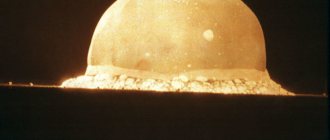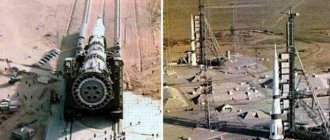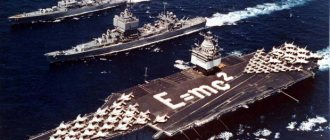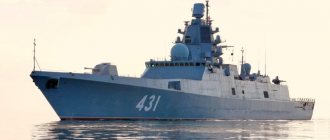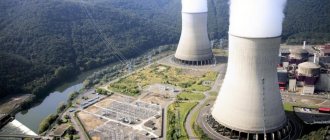What's stopping you from enjoying Orion's first flight?
The past week was marked by the successful first test launch of the Orion spacecraft. It would seem that life is wonderful - today there is an unmanned launch, and on a historical scale, “tomorrow” astronauts will step onto Mars. However, not everything is so simple in the run-up for the “big jump”. What does the current situation look like if you try to compare it with the US lunar program and the Constellation program?
AS-202 and tempos
If you try to compare the Orion mission EFT-1 with the Apollo missions, the missions AS-201 and AS-202 will be the closest. In all three cases:
- A lighter launch vehicle is used (Saturn IV and Delta IV Heavy).
- The altitude of the apocenter does not exceed 10,000 km.
- The atmospheric entry speed does not exceed 9 km/s.
Wikipedia has already written that the EFT-1 mission is an analogue of Apollo 4, but I disagree with this. Apollo 4 used the standard Saturn V super-heavy launch vehicle, and the re-entry speed exceeded 11 km/s. And the differences between EFT-1 and AS-201 and -202 are not in Orion’s favor. On test flights, Apollos were fully equipped - a command module, a service module, and a rescue system. Orion flew with a mass-dimensional mock-up of the service module, which had no engines, no fuel, no solar panels. In theory, this is not scary - the service module is made on the basis of the developed European ATV cargo ship, but, in any case, checking the service module would be useful, and the service module engine could accelerate the command module to a higher speed in order to better simulate re-entry into the atmosphere at returning from the Moon/Mars. Let's now try to estimate the pace of progress of the Apollo and Orion programs. To date, the following Orion missions are known:
- EFT-1, took place on December 5, 2014, an unmanned test flight in low-Earth orbit.
- EM-1, deadlines have already moved from 2022 to the end of 2022, unmanned test flight to the Moon on the SLS launch vehicle.
- EM-2, 2022 has already become the "2020s", the first manned launch, originally planned for an asteroid, but its purpose is now unclear.
- EM-3, 2023, the goal is also unclear, perhaps a flight to an asteroid.
- The final goal is Mars, let’s call it “EM-Mars”, the time frame is “2030s”.
This set of missions does not correspond directly to the Apollo program, but, nevertheless, the missions can be roughly aligned:
- EFT-1 is AS-201 because this is the first launch of the new ship.
- EM-1 - Apollo-4, because both tests a new super-heavy rocket.
- EM-2 - Apollo-7, because this is the first manned launch (I assumed that EM-2 would still be a test of Orion and not a flight directly to an asteroid).
- EM-3 or EM-Mars - Apollo 11. EM-3 is a very serious stretch, it may be more correct to compare it with Apollo 10 or even -8, but between the seventh and eighth, as well as the tenth and eleventh Apollos Only two months have passed, the difference in the pace of progress of projects will be terrifying.
Let's try to create the following table:
A somewhat bleak picture emerges. Even if we do not take into account the fact that the development of Orion has been carried out since 2004 as part of the Constellation program, and we leave the current predictions of the timing, which for EFT-1 have already moved forward by a year and a half (the mission was originally planned for July 2013), it turns out , that if we call EM-3 a mission comparable to Apollo 11, then the pace of movement of the Orion project is more or less normal 2.6 times slower. But if you compare only the first man landing on the Moon with the first man landing on Mars, then development is a dismal 6 times slower. This difference leads to the fact that the quantitative difference turns into a qualitative one - even for the 2020s, plans are now very unclear. In addition, the more often a technique is used, the better it is known. Combining ship testing with ambitious goals in space is very risky.
Money
The second big sadness of the Orion program is the financial situation. There is the famous NASA budget chart:
The graph shows NASA's budget as a percentage of the US budget.
In 2013, NASA’s budget set a sad anti-record, falling below 0.5% of the US budget. Maybe a new surge in funding awaits us? Let's take an official document - NASA's 2015 budget request. How does the agency itself see its future?
Please note that the spending structure of the agency plans will not change. The ISS needs a lot of money (green), there are no plans to curtail research programs (blue). And the line for the development of new ships highlighted in orange is almost entirely spent on the development of Orion and SLS. Such plans provide a clue why the mission to the asteroid has moved from 2022 to the 2020s - Orion on the SLS can at most be sent on an Apollo 8-style flyby of the Moon. An “asteroid module” is needed for an asteroid, a lunar one for the moon, and money for their development is not even planned. There is, of course, the option that they are “hidden” in existing columns, but this is highly unlikely - large amounts are needed. Separately, a warning sign should be noted - look at the Education column. Falling spending on grants and education projects means the agency is forced to cut corners. Outside NASA, the situation doesn't look rosy either. In 1961, when President Kennedy announced the lunar program, the US economy and budgetary structure looked better than it does now. The economy grew rapidly, and public debt as a percentage of GDP fell steadily:
The United States did not have time to get involved in the war in Vietnam (and now it is spending resources on the situation in Iraq and Afghanistan). And I'm not talking about the many smaller problems. Under such conditions, it is extremely unlikely that a new Kennedy will appear and announce a significant increase in spending on space.
Idea
Economics is a soulless thing.
But man is not an absolutely rational being; he can be inspired and convinced to sacrifice some of his comfort for the sake of a great goal. Listen to President Kennedy's speech at Rice University in 1962: The video is fast forwarded to the climax, but I would recommend watching the entire video and reading the Russian translation if you do not understand English by ear. This is a historic speech that inspired a generation. At the time of the speech, the United States had carried out only 4 manned flights into space with a total duration of 10 hours, the number of satellites launched was measured in dozens, and the USSR was leading the space race by a huge margin. And Kennedy talked about flying to the moon! And he spoke honestly - it will be difficult, it will be expensive, but it can give us enormous benefits. Yes, he turned out to be only partially right - satellites brought great practical benefits, and the benefits of the lunar program can only be measured indirectly - through the dissemination of related technologies. But the leap into space, the civilizational turn, became one of the factors that led us to today's world. But if we return to the present time, the situation will be reversed.
Fall of "Constellation"
In 2004, the Constellation program was launched, which would result in the Ares I and Ares V launch vehicles, the Orion spacecraft, a return to the Moon no later than 2022, and the ultimate goal of Mars.
In 2009, there was even a successful test flight of Ares IX, which tested the first stage of the Ares I rocket, which is a modification of the Space Shuttle solid rocket booster. However, in 2010, newly elected President Obama accused the Constellation program of being over budget, missing deadlines, and lacking innovation. The light and heavy Ares projects were closed. President Obama spoke at the Space Center. Kennedy:
Now, five years later, we can see what he promised and what was done:
- Increase NASA's budget by $6 billion over 5 years. Not done.
- Focus on private space companies (transition from ordering ships to ordering transport services). Performed.
- Development of a rescue ship for the ISS based on Orion. Not done.
- Development of a new heavy rocket with completion of design no later than 2015. Development of the SLS launch vehicle is underway
. - Going to space is more frequent, bigger and cheaper in the 2020s.
- Manned missions beyond lunar orbit by 2025. Flight to an asteroid.
- A mission to Mars orbit in the mid-2030s and then a landing mission.
The Orion ship was also part of the Constellation program, and, as we now know, they wanted to make a rescue ship out of it in 2010. However, in May 2011, it was announced that Orion would retain its mission as a spacecraft beyond Earth's orbit, and that the Ares family of launch vehicles would be replaced by the SLS super-heavy launch vehicle. The next US presidential election is in 2016, and knowledge of the fate of the Constellation program raises concerns that today's program could be shut down in a similar manner in 2022.
And about technology
I don’t know about you, but I was a little offended by the commentator’s phrase at the launch of Orion - “the dawn of Orion and the dawn of a new era of American space exploration.” And it’s not even about the external similarity of Orion to Apollo. The Orion landing system with two drogue parachutes, three main chutes and inflatable balloons for turning the hatch up in the water is completely similar to the Apollo. The rescue system is inherited from the Ares I launch vehicle. Solid propellant rockets explode with burning fragments scattered, the rescue system is much more powerful, and therefore it is so much larger than the Apollo SAS. The service module has a smaller main diameter and resettable panels. Yes, on the one hand, they will hide solar panels underneath and carry the power load during extraction, but in fact, the double wall of the service module still looks irrational. The future SLS rocket uses the same mixture of the Space Shuttle and the Saturn family of launch vehicles as the closed Ares. Every big space program has problems with schedules and budget overruns, so if Orion ever wants to be shut down again for being “overtime, underbudget, and lacking innovation,” it would be hard to argue. Now, after the first test flight of Orion, and almost five years after the closure of Constellation, it is even somewhat funny to read, for example, such reviews:
“We can hardly afford the cost of “Apollo on steroids,” as the former NASA Administrator called the Ares/Orion program”
- Elon Musk, head of SpaceX.
P.S
It doesn't take a psychic to predict the obvious ad hominem argument to what I wrote. “You’re just jealous of American success and you’ve deliberately made a fool of yourself.” In addition to reminding you that an argument to a person is a type of demagoguery, I’ll say it frankly. I love my country and would like to see my fellow citizens land on the moon, fly to Mars and beyond. But this does not prevent me from rejoicing in the successes of others, and, returning to Orion, I would like its future to be more cloudless.
How will the test flight take place?
The test flight will take place without people on board at an altitude of 5800 km and will take 4.5 hours. The ship will enter the dense layers of the atmosphere at a speed of about 32 thousand km/h, the temperature on its surface will reach 2.2 thousand degrees Celsius. At the end of the test flight, the device should splash down in the Pacific Ocean.
The second test flight of Orion will not take place until 2022, and the first manned launch is scheduled for 2022.
Orion spacecraft. Photo: Reuters
